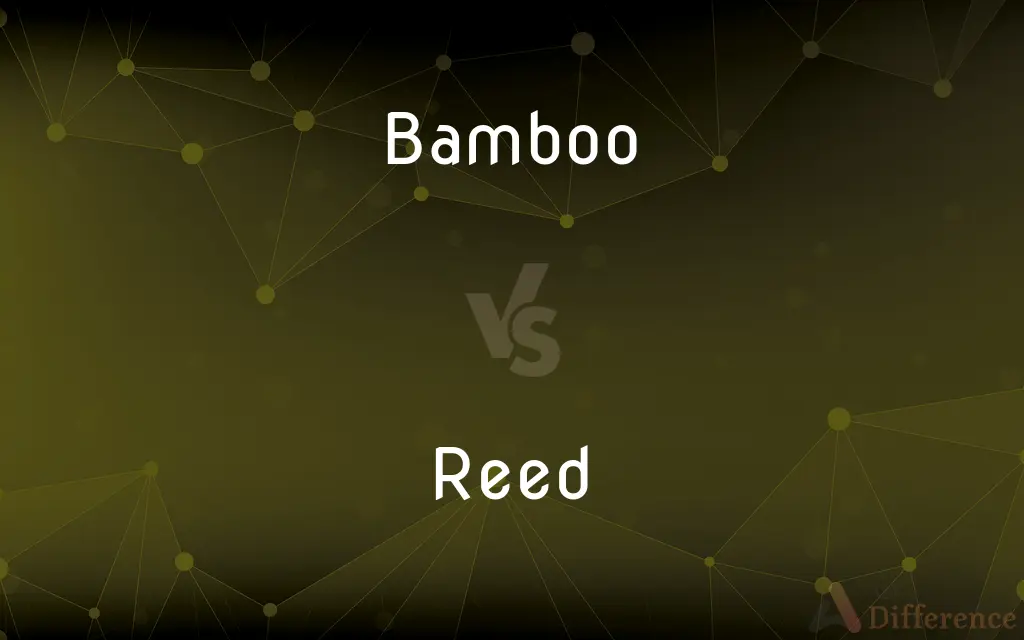Bamboo vs. Reed — What's the Difference?
By Maham Liaqat & Urooj Arif — Updated on March 26, 2024
Bamboo is a fast-growing, woody grass used in construction and crafts, notable for its strength and height. Reed is a flexible, slender plant found in wetlands, often used for weaving and making musical instruments.

Difference Between Bamboo and Reed
Table of Contents
ADVERTISEMENT
Key Differences
Bamboo is known for its rapid growth and ability to reach substantial heights, making it an excellent resource for construction materials, furniture, and sustainable products. Whereas, reeds are generally smaller, more flexible plants commonly found in wetlands and are used in a variety of applications, including weaving, thatching roofs, and manufacturing musical instruments.
The structural integrity of bamboo allows it to be used in heavy construction, such as building frames and scaffolding, thanks to its remarkable strength-to-weight ratio. On the other hand, reeds, due to their flexibility and strength, are often used in lighter construction and crafts, such as mats, baskets, and even traditional roofing materials.
Bamboo can be processed into a wide range of products, including textiles, flooring, and paper, demonstrating its versatility. Meanwhile, reeds are primarily valued for their natural state and are used in their raw form for crafts, decoration, and in the construction of reed instruments like clarinets and saxophones.
Environmental sustainability is a significant advantage of bamboo, as it absorbs carbon dioxide and grows back quickly after harvesting, making it a renewable resource. Reed beds also play a crucial ecological role by filtering water, providing habitats for wildlife, and preventing soil erosion in wetland areas.
While both bamboo and reed contribute to eco-friendly practices, bamboo is more widely recognized for its role in green building and sustainable product design. Reeds, though not as globally commercialized as bamboo, are indispensable in their niche applications and environmental contributions.
ADVERTISEMENT
Comparison Chart
Growth Environment
Prefers tropical and subtropical climates
Thrives in wetlands and aquatic environments
Uses
Construction, furniture, textiles, paper
Weaving, thatching, musical instruments
Structural Property
Strong and sturdy, suitable for heavy construction
Flexible and slender, used for light construction and crafts
Environmental Impact
Absorbs CO2, quickly renewable
Filters water, provides habitats, prevents soil erosion
Commercial Use
Widely commercialized for a variety of products
Used in niche markets, less globally commercialized
Compare with Definitions
Bamboo
Serves as an essential construction material in many cultures, particularly in Asia.
Bamboo scaffolding is commonly seen in construction sites across Asia.
Reed
A type of tall, slender grass found in wet areas, used for weaving and as a material for musical instruments.
Reed mats are commonly used in homes for their natural look and feel.
Bamboo
A tall, fast-growing woody grass that is used extensively in construction and manufacturing.
Bamboo flooring has become popular due to its durability and aesthetic appeal.
Reed
Used to make the vibrating component in woodwind instruments like clarinets and saxophones.
The quality of the reed significantly affects the sound of a clarinet.
Bamboo
Used in the production of eco-friendly textiles due to its soft fibers.
Bamboo fabric is favored for its breathability and moisture-wicking properties.
Reed
Flexible and versatile, reeds are utilized in traditional crafts and thatching roofs.
Thatched reed roofs are traditional in many English cottages.
Bamboo
Bamboo shoots are edible and considered a delicacy in many cuisines.
Bamboo shoots are often used in Asian dishes for their crunchy texture and sweet flavor.
Reed
Reeds are harvested sustainably, ensuring their ecological role is preserved.
Sustainable harvesting of reeds supports both local industry and wetland conservation.
Bamboo
Known for its rapid growth, making it a sustainable alternative to traditional hardwoods.
Bamboo can grow up to a meter per day under the right conditions.
Reed
Plays a critical role in wetland ecosystems, providing habitats and purifying water.
Reed beds are essential for maintaining the biodiversity of wetlands.
Bamboo
Bamboos are a diverse group of evergreen perennial flowering plants in the subfamily Bambusoideae of the grass family Poaceae. The origin of the word "bamboo" is uncertain, but it probably comes from the Dutch or Portuguese language, which originally borrowed it from Malay or Kannada.In bamboo, as in other grasses, the internodal regions of the stem are usually hollow and the vascular bundles in the cross-section are scattered throughout the stem instead of in a cylindrical arrangement.
Reed
A tall, slender-leaved plant of the grass family, which grows in water or on marshy ground.
Bamboo
Any of various usually woody, temperate or tropical plants chiefly of the genera Arundinaria, Bambusa, Dendrocalamus, Phyllostachys, or Sasa in the grass family. Certain species of bamboo can reach heights of 20 to 30 meters (66 to 98 feet).
Reed
A weak or impressionable person
The jurors were mere reeds in the wind
Bamboo
The hard or woody, jointed, often hollow stems of these plants, used in construction and to make various kinds of utensils.
Reed
A piece of thin cane or metal, sometimes doubled, which vibrates in a current of air to produce the sound of various musical instruments, as in the mouthpiece of a clarinet or oboe or at the base of some organ pipes
A reed instrument
Bamboo
Fabric or yarn manufactured from these plants.
Reed
An electrical contact used in a magnetically operated switch or relay
A reed relay
The permanent magnet closes the reeds and contacts together
Bamboo
A fast-growing grass of the Bambusoideae subfamily, characterised by its woody, hollow, round, straight, jointed stem.
Reed
A comblike implement (originally made from reed or cane) used by a weaver to separate the threads of the warp and correctly position the weft.
Bamboo
(uncountable) The wood of the bamboo plant as a material for building, furniture, etc.
Reed
A set of semi-cylindrical adjacent mouldings like reeds laid together.
Bamboo
(countable) A stick, rod, pole, or cane of bamboo, especially one used for corporal punishment.
Reed
Any of various tall perennial grasses, especially of the genera Phragmites and Arundo, having hollow stems and large plumelike panicles and growing in wetlands.
Bamboo
(slang) A didgeridoo.
Reed
Any of several similar plants, such as the papyrus.
Bamboo
(slang) A member of the British military or British East India Company who spent so much time in Indonesia, India, or Malaysia that they never went back home.
Reed
The stalk of any of these plants.
Bamboo
Made of the wood of the bamboo.
Reed
A collection of these stalks
Reed for making baskets.
Bamboo
(transitive) To flog with a bamboo cane.
Reed
(Music) A primitive wind instrument made of a hollow reed stalk.
Bamboo
(transitive) To paint (furniture, etc.) to give it the appearance of bamboo.
Reed
A flexible strip of cane or metal set into the mouthpiece or air opening of certain instruments to produce tone by vibrating in response to a stream of air.
Bamboo
To penetrate sexually.
Reed
An instrument, such as an oboe or clarinet, that is fitted with a reed.
Bamboo
A plant of the family of grasses, and genus Bambusa, growing in tropical countries.
Reed
A narrow movable frame fitted with reed or metal strips that separate the warp threads in weaving.
Bamboo
To flog with the bamboo.
Reed
(Architecture) A reeding.
Bamboo
The hard woody stems of bamboo plants; used in construction and crafts and fishing poles
Reed
(countable) Any of various types of tall stiff perennial grass-like plants growing together in groups near water.
Bamboo
Woody tropical grass having hollow woody stems; mature canes used for construction and furniture
Reed
(countable) The hollow stem of these plants.
Reed
Part of the mouthpiece of certain woodwind instruments, comprising a thin piece of wood or metal which shakes very quickly to produce sound when a musician blows over it.
Reed
A musical instrument such as the clarinet or oboe, which produces sound when a musician blows on the reed.
Reed
A comb-like part of a beater for beating the weft when weaving.
Reed
A piece of whalebone or similar for stiffening the skirt or waist of a woman's dress.
Reed
Reeding.
Reed
(mining) A tube containing the train of powder for igniting the charge in blasting.
Reed
Straw prepared for thatching a roof.
Reed
A missile weapon.
Reed
A measuring rod.
Reed
A Babylonian unit of measure the length of a reed, equal to half a nindan, or six cubits.
Reed
The fourth stomach of a ruminant; rennet.
Reed
(transitive) To thatch.
Reed
To mill or mint with reeding.
Reed
Simple past tense and past participle of ree
Reed
Red.
Reed
Same as Rede.
Reed
The fourth stomach of a ruminant; rennet.
Reed
A name given to many tall and coarse grasses or grasslike plants, and their slender, often jointed, stems, such as the various kinds of bamboo, and especially the common reed of Europe and North America (Phragmites communis).
Reed
A musical instrument made of the hollow joint of some plant; a rustic or pastoral pipe.
Arcadian pipe, the pastoral reedOf Hermes.
Reed
An arrow, as made of a reed.
Reed
Straw prepared for thatching a roof.
Reed
A small piece of cane or wood attached to the mouthpiece of certain instruments, and set in vibration by the breath. In the clarinet it is a single fiat reed; in the oboe and bassoon it is double, forming a compressed tube.
Reed
A frame having parallel flat stripe of metal or reed, between which the warp threads pass, set in the swinging lathe or batten of a loom for beating up the weft; a sley. See Batten.
Reed
A tube containing the train of powder for igniting the charge in blasting.
Reed
Same as Reeding.
Reed
Tall woody perennial grasses with hollow slender stems especially of the genera Arundo and Phragmites
Reed
United States journalist who reported on the October Revolution from Petrograd in 1917; founded the Communist Labor Party in America in 1919; is buried in the Kremlin in Moscow (1887-1920)
Reed
United States physician who proved that yellow fever is transmitted by mosquitoes (1851-1902)
Reed
A vibrator consisting of a thin strip of stiff material that vibrates to produce a tone when air streams over it;
The clarinetist fitted a new reed onto his mouthpiece
Reed
A musical instrument that sounds by means of a reed
Common Curiosities
Can both bamboo and reed be used in construction?
Yes, but bamboo is suitable for heavy construction, whereas reed is typically used for thatching roofs and in light crafts.
What is bamboo?
Bamboo is a fast-growing, woody grass that is widely used in construction, crafts, and textiles.
What is a reed?
A reed is a slender, flexible plant found in wetlands, used in weaving, thatching, and making musical instruments.
Are bamboo and reed environmentally friendly materials?
Both are considered eco-friendly; bamboo grows quickly and absorbs CO2, while reeds help in water filtration and habitat provision.
How does the growth environment of bamboo differ from reed?
Bamboo thrives in tropical to subtropical climates, while reed prefers wetland areas.
Is bamboo edible?
Yes, bamboo shoots are edible and used in various cuisines for their unique flavor and texture.
What are the environmental benefits of reeds?
Reeds filter water, prevent soil erosion, and provide essential habitats for wildlife in wetland ecosystems.
How do bamboo and reed differ in use?
Bamboo is used for structural purposes, textiles, and furniture, while reed is often used for weaving, crafts, and in musical instruments.
What makes bamboo a sustainable alternative to wood?
Its rapid growth rate and ability to regenerate after cutting make bamboo a sustainable and renewable resource.
How are reeds used in music?
Reeds are used as the vibrating component in woodwind instruments, such as clarinets and saxophones.
Can reed beds improve water quality?
Yes, reed beds can significantly improve water quality by filtering pollutants and providing aeration.
Share Your Discovery

Previous Comparison
Aioli vs. Remoulade
Next Comparison
Grade vs. ClassAuthor Spotlight
Written by
Maham LiaqatCo-written by
Urooj ArifUrooj is a skilled content writer at Ask Difference, known for her exceptional ability to simplify complex topics into engaging and informative content. With a passion for research and a flair for clear, concise writing, she consistently delivers articles that resonate with our diverse audience.













































